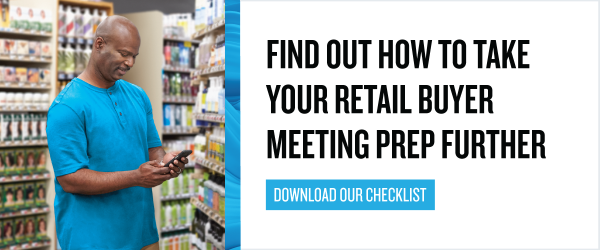We bet that you got into the consumer packaged goods (CPG)—sometimes referred to as fast-moving consumer goods (FMCG) business—because you knew how to make a great non-durable, consumable product that you believe in and that people will love.
But then you have that first meeting with a retail buyer, and all the buyer wants to know is if your product is going to increase retail revenue. And the buyer uses an array of words, terms, acronyms, and metrics to describe exactly that: “If we bring in your product, what do you project your unit sales per million to be in the next quarter?” Or: “We see you already have placement in Midsize Retail Chain X. What’s the % ACV of your product in that channel?”
How conversant you are in this kind of retail buyer language may mean the difference between finding yourself at a negotiating disadvantage and getting the prime placement your product deserves.
With that in mind, here are three key terms retail buyers expect you to know (and how you can use them to your advantage):
Velocity
As the name suggests, “velocity” describes how quickly a product is selling compared to similar products across markets and outlets. This is often expressed in “unit sales per MM ACV” or “sales rate,” which measures the total sales (in dollars) of a given product per one million dollars of overall volume. Overall volume is expressed in ACV, which stands for “all-commodity volume.” It basically speaks to how efficiently a product is moving relative to its distribution. The other common velocity metric is “unit sales per point of distribution,” or “sales volume,” which is useful for comparing sales rates of products within a single geography.
Velocity is crucial to understand not only because it indicates how quickly your product is selling, but also because of its impact on retailers’ businesses. Your buyers want to be assured that your product—or CPG products like yours in the category—will sell briskly before they commit to an order; velocity gives them a tangible demonstration of that.
% ACV
Percent ACV sounds super-technical but is actually just a measure of the distribution of all of a brand’s products weighted by the size of the stores that carry them. ACV is simply the dollar volume of everything a store sells in a given period. Because distribution in large stores is more valuable to you as the manufacturer than distribution in small stores, this is an important number to know.
% ACV is a bedrock metric in retail, and understanding it is key to navigating buyer meetings. Knowing where your product or your competitors’ products fit into a retailer’s overall distribution is crucial to demonstrating value.
Remaining market/ROM
Remaining market, or “rest of market” (ROM), can be your ace in the hole when meeting with a retail buyer. This describes retailers’ competition in a geographical area, which products they carry and how they’re performing. With this information, you can make a compelling case for your product and show how it can boost the buyer’s ability to compete with their closest rivals.
Being familiar with these key terms can help immensely in buyer meetings, and in crafting a sales story. And though it may be easy to get lost in the terminology and the volume of data CPG retailers expect you to know, this is a good first step in understanding the market and your place in it. NielsenIQ can help you access the data behind these metrics; contact us today to get started.
Find out how to take your retail buyer meeting prep further
You’ve got the key retail buyer and business terms down, now what? If you want to really take your meeting prep to the next level, you’ll also want to make sure you’re setting the right KPIs to track and measure your product’s performance from the start. Keep our checklist handy so that you’re always ready for How to Prepare for a Retailer Buyer Meeting in 5 Easy Steps.




